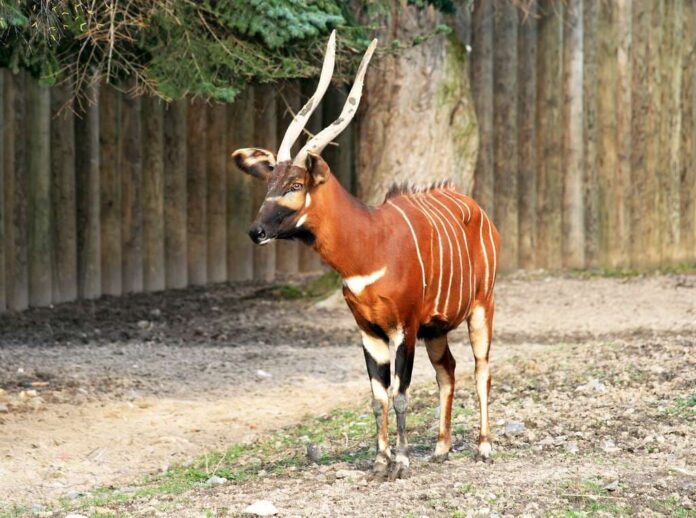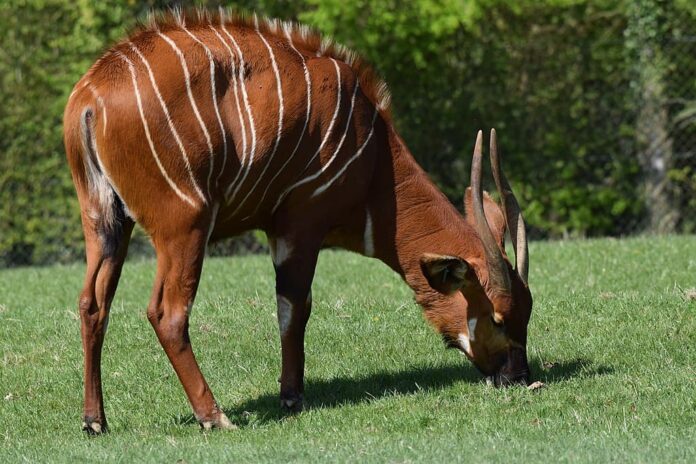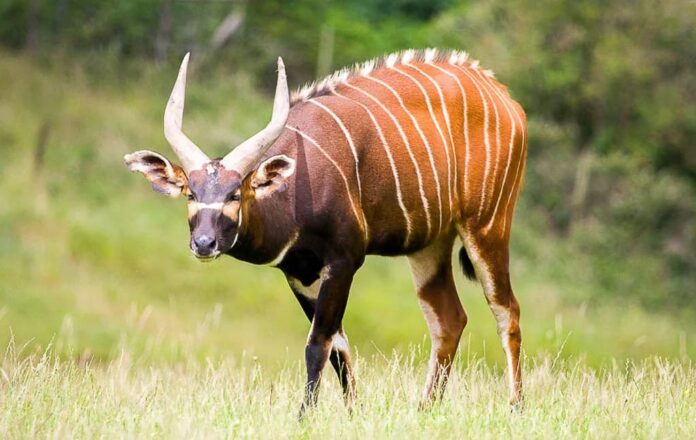Bongo is a very striking antelope species that stands out beautifully with its unique markings. Their appearance is also associated with superstitions and how people in their native ranges respect them. Native people believe that if they eat or touch a bongo, they will have spasms similar to epileptic seizures. Let’s find out more about this incredible animal together with me below.
1Appearance

Standing up to 1.1 to 1.3 meters tall, bongos are the world’s third-largest antelopes and the largest forest antelopes. The bongo is a large antelope that stands out from the rest due to its white-yellow stripes on its reddish-brown coat. There are usually 10 to 15 vertical stripes that spread along the back from the base of their neck to the rump. They also have a thin male that runs along their body from their shoulder to the rump. Male bongos have darker coats of mahogany brown while female bongos have brighter coats.
Another distinctive feature is the white chevron between their eyes, and two large white spots on each cheek. Bongos have large ears for sharp hearing and a long prehensile tongue that allows them to grip onto fresh leaves higher up. More than that, they also have long horns that are slightly spiral and range between 75 to 99 centimeters. The most interesting part is that bongo is the only tragelaphid species with horns in both sexes. However, the horns of the males are longer and more massive than that of the females.
2Behavior

In general, bongos are easily frightened and are very shy so they will immediately run away after a scare. Bongos are nocturnal, males are solitary while females with young live in groups of 6 to 8. Even when hanging out in herds, the number is never more than 20 individuals. And when young males mature, they will leave their maternal groups to dwell on their own. Adult males of a similar age or size usually avoid each other, and they will fight when meet though rare. Males only seek females during the mating season before they go back to being solitary again.
3Feeding & Habitats

Native to sub-Saharan Africa, these forest-dwelling antelopes live in dense forest mosaics and tropical jungles of Africa. They like places that provide fresh low-level green vegetation where they can feed on bark, bushes, leaves, and vines. Along with that, they also consume cereals, fruits, grasses, herbs, pith of rotting trees, and roots. On top of that, bongos require salt in their diets so it is common for them to regularly visit natural salt licks. This is why it is not strange to see them eating burned wood after a storm. That is a rich source of minerals and salt that they need.
4Threats
There are two bongo species in the world, the eastern or mountain bongo and the western or lowland bongo. Both of them are facing threats, the former is considered Critically Endangered by the latter is classified as Near Threatened. Two of the main threats to their populations are logging and poaching for meat. Habitat loss for agriculture and uncontrolled timber cutting is a very serious threat to their number. Meanwhile, humans prey on them for their horns, meat, and pelts through hunting, poaching, and trapping. Besides these, they are also being preyed on by natural predators such as leopards, lions, pythons, and spotted hyenas.
Related Post: Largest Antelopes In The World




